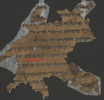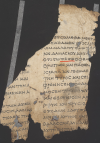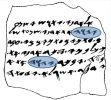For those who do not know, the word tetragrammaton means "four letters" and refers to the four Hebrew letters of the divine name (i.e. yodh, he, waw, he = YHVH). The divine name has an interesting history within the Old Testament manuscript tradition, both Hebrew and Greek.
During their time in exile, the Jews moved from the Paleo-Hebrew script to what is call the Aramaic Square script and continued to use it afterwards. This script is known as Ktav Ashuri. The phrase mean "Assyrian script\writing." Most of you, I am sure, have seen this script.
First occurrence of the tetragrammaton is in Genesis 2:4.
אלה תולדות השמים והארץ בהבראם ביום עשות יהוה אלהים ארץ ושמים
Here is an example of the square script from the Great Isaiah Scroll.

The above is normal and is expected. However, not all square script texts used the square text form of the tetragrammaton. As you can see from the fragment below, other manuscripts use the Paleo-Hebrew script form for the divine name.

Now this where it really gets interesting to me. Below is a fragment of the Septuagint which is a Greek translation of the Old Testament. Yet the divine name is written in the Paleo-Hebrew script in a Greek text.

It is interesting to me that the Jews would continue to written the divine name in the ancient Paleo-Hebrew script long after they had adopted the Aramaic Square script for their manuscripts. And what is even more interesting is they would used the Paleo-Hebrew script in the LXX a Greek text. It makes one wonder if the Paleo-Hebrew script form of the name itself held a special significance for some scribes.
I hope this was not too boring for you. I find the study of scribal practices and papyrology thought-provoking.
During their time in exile, the Jews moved from the Paleo-Hebrew script to what is call the Aramaic Square script and continued to use it afterwards. This script is known as Ktav Ashuri. The phrase mean "Assyrian script\writing." Most of you, I am sure, have seen this script.
First occurrence of the tetragrammaton is in Genesis 2:4.
אלה תולדות השמים והארץ בהבראם ביום עשות יהוה אלהים ארץ ושמים
Here is an example of the square script from the Great Isaiah Scroll.

The above is normal and is expected. However, not all square script texts used the square text form of the tetragrammaton. As you can see from the fragment below, other manuscripts use the Paleo-Hebrew script form for the divine name.

Now this where it really gets interesting to me. Below is a fragment of the Septuagint which is a Greek translation of the Old Testament. Yet the divine name is written in the Paleo-Hebrew script in a Greek text.

It is interesting to me that the Jews would continue to written the divine name in the ancient Paleo-Hebrew script long after they had adopted the Aramaic Square script for their manuscripts. And what is even more interesting is they would used the Paleo-Hebrew script in the LXX a Greek text. It makes one wonder if the Paleo-Hebrew script form of the name itself held a special significance for some scribes.
I hope this was not too boring for you. I find the study of scribal practices and papyrology thought-provoking.


